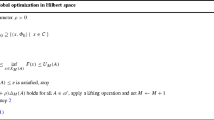Abstract
A non convex optimization problem, involving a regular functional J, on a closed and bounded subset S of a separable Hilbert space V is here considered. No convexity assumption is introduced. The solutions are represented by using a closed formula involving means of convenient random variables, analogous to Pincus (Oper Res 16(3):690–694, 1968). The representation suggests a numerical method based on the generation of samples in order to estimate the means. Three strategies for the implementation are examined, with the originality that they do not involve a priori finite dimensional approximation of the solution and consider a hilbertian basis or enumerable dense family of V. The results may be improved on a finite-dimensional subspace by an optimization procedure, in order to get higher-quality solutions. Numerical examples involving both classical situation and an engineering application issued from calculus of variations are presented and establish that the method is effective to calculate.



Similar content being viewed by others
References
Souza de Cursi, J.E.: Numerical methods for linear boundary value problems based on Feyman–Kac representations. Comput. Math. Simul. 36, 1–16 (1994)
Milshtein, G.N.: The solving of a boundary value problem by numerical integration of stochastic equations. Comput. Math. Simul. 38, 77–85 (1995)
Morillon, J.P.: Numerical solution of linear mixed boundary value problems using stochastic representations. Int. J. Numer. Methods Eng. 40, 387–405 (1997)
Talay, D., Vaillant, O.: A stochastic particle method for the McKean–Vlasov and the Burgers equation. Math. Comput. 66(27), 157–192 (1997)
Souza de Cursi, J.E.: A Feynman–Kac method for the determination of the Stefan’s free boundary. In: Proceedings of the International Congress on Inverse Problems in Engineering. Angra dos Reis, Brazil (2002)
Pincus, M.: A closed formula solution of certain programming problems. Oper. Res. 16(3), 690–694 (1968)
Bez, E., Gonçalves, M.B., Souza de Cursi, J.E.: A hybrid method for continuous global optimization involving the representation of the solution. In: Proceedings of the 6th. World Congress on Structural and Multidisciplinary Optimisation. Rio de Janeiro, Brazil (2005)
Koscianski, A., Souza de Cursi, J.E.: Physically constrained neural networks and regularization of inverse problems. In: Proceedings of the 6th World Congress on Structural and Multidisciplinary Optimisation. Rio de Janeiro, Brazil (2005)
Souza de Cursi, J.E.: Representation and numerical determination of the global optimizer of a continuous function on a bounded domain. In: Floudas, C.A., Pardalos, P. (eds.) Advances in Convex Analysis and Global Optimization, pp. 517–540. Kluwer, Netherlands (2004)
Bez, E., Gonçalves, M.B., Souza de Cursi, J.E.: A numerical method for global optimization based on the representation of the solution. TEMA 5(2), 185–194 (2005)
Artzner, P.: Extension du théorème de Sazonov-Minlos d’aprè s L. Schwarz. Séminaire de Probabilités de Strasbourg, Tome 3, 1–23 (1969)
Souza de Cursi, J.E.: Representation of solutions in variational calculus. In: Tarocco, E., de Souza Neto, E.A., Novotny, A.A. (eds.) Variational Formulations in Mechanics: Theory and Applications, pp. 87–106. International Center for Numerical Methods in Engineering—CIMNE, Barcelona (2007)
Bez, E., Gonçalves, M.B., Souza de Cursi, J.E.: A procedure of global optimization and its application to estimate parameters in interaction spatial models. Int. J. Simul. Multidiscip. Design Optim. 4, 85–100 (2010)
Nelder, J.A., Mead, R.: A simplex method for function minimization. Comput. J. V7, 308–313 (1965)
Kennedy, J., Eberhart, R.C.: Particle swarm optimization. In: Proceedings of IEEE International Conference on Neural Networks (ICNN’95), vol. 4, pp. 1942–1948. IEEE Service Center, Perth, November–December 1995
Eberhart, R.C., Kennedy, J.: A new optimizer using particle swarm theory. In: Proceedings of the Sixth International Symposium on Micro-Machine and Human Science, pp. 39–43. Nagoya, Japan (1995)
Avriel, M.: Nonlinear Programming: Analysis and Methods. Prentice-Hall, Englewood Cliffs (1976)
Luenberger, D.G.: Introduction to Linear and Nonlinear Programming. Stanford University, Stanford (1973)
Pedregal, P.: Introduction to Optimization. Springer, New York (2004)
Komzsik, L.: Applied Calculus of Variations for Engineers. CRC Press, New York (2008)
Author information
Authors and Affiliations
Corresponding author
Rights and permissions
About this article
Cite this article
Zidani, H., De Cursi, J.E.S. & Ellaia, R. Numerical approximation of the solution in infinite dimensional global optimization using a representation formula. J Glob Optim 65, 261–281 (2016). https://doi.org/10.1007/s10898-015-0357-5
Received:
Accepted:
Published:
Issue Date:
DOI: https://doi.org/10.1007/s10898-015-0357-5




